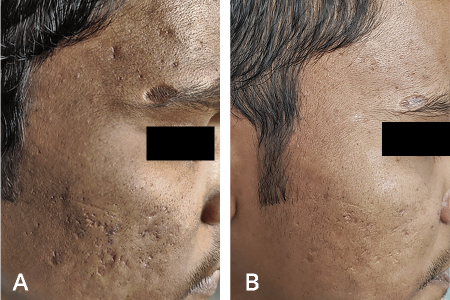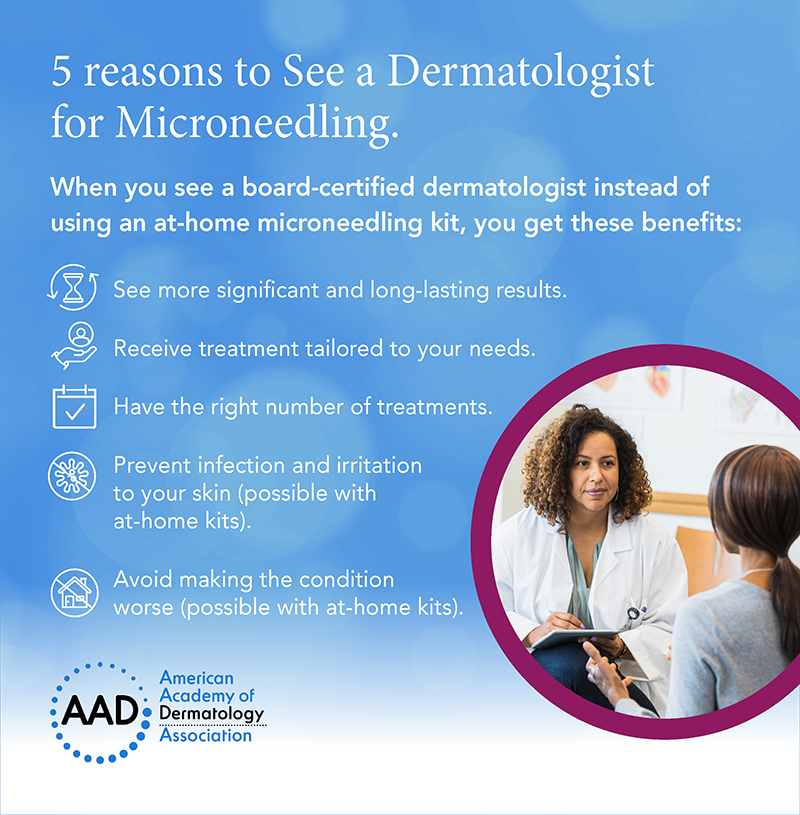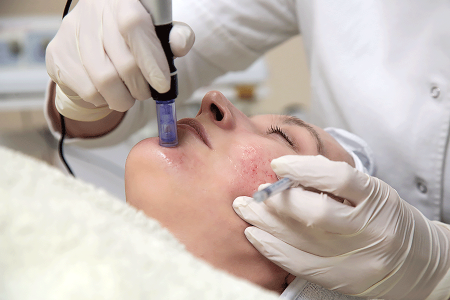Microneedling can fade scars, uneven skin tone, and more
What is microneedling?
Microneedling is a medical treatment that uses tiny needles to puncture the skin. Dermatologists use it to diminish:
Acne scars
Dark spots
Large pores
Melasma
Sagging skin
Scars due to surgery or an injury
Stretch marks
Uneven skin texture and tone
Wrinkles and fine lines
Microneedling is minimally invasive and safe for all skin tones. It works by stimulating your body to make collagen. This is why it’s also called “collagen induction therapy.”
When properly performed, your body responds by healing the holes in your skin with just the right amount of collagen. This can lead to less noticeable scars and wrinkles, and more even skin tone and texture.
Before (A) and after (B) microneedling performed by a board-certified dermatologist
This patient received microneedling and platelet-rich plasma, which dramatically faded his acne scars (B).

Are the results the same whether you use an at-home microneedling device or see a dermatologist?
Products sold for at-home microneedling and microneedling performed in a non-medical spa aren’t meant to puncture the skin. These gentler products lead to less noticeable results than those you get from a dermatologist.
At-home microneedling can also be risky. Here’s why:
You may overuse microneedling. Overusing microneedling can irritate your skin, which can make the skin concern more noticeable and your skin uncomfortable.
Sometimes an at-home microneedling product pierces the skin. This could lead to an infection or scarring.
At-home microneedling can accidentally spread warts, herpes, and other viruses across the skin.
Pressing too hard can damage your skin. This damage can cause scarring or changes to your skin’s color or texture.

What microneedling results can you expect when you see a dermatologist?
When you see a board-certified dermatologist, you will have more significant and long-lasting improvement than with DIY microneedling or microneedling performed in a non-medical spa.
Dermatologist performing microneedling
This cosmetic treatment is often used to treat acne scars, scars caused by an injury, and surgical scars.

By seeing a dermatologist, you’ll also find out whether microneedling is the right treatment for your condition. If it is, your dermatologist may use a microneedling pen, roller, or one of the following:
Radiofrequency microneedling: This is a type of microneedling that adds heat to your treatment. The heat travels down the needles. Adding heat can increase your body’s ability to produce collagen, which can improve the results you see.
Radiofrequency microneedling is safe for all skin tones. Some studies suggest that this treatment can give you the same results as a laser, but with less downtime and possible side effects. These studies were conducted on a small number of people with darker skin tones. More research is needed to know if this applies equally to people with different skin tones and to a larger number of people with darker skin tones.
Microneedling with platelet rich plasma (PRP): Using both of these treatments can improve your body’s ability to make collagen.
When treated with a combination of microneedling and PRP, you will have a small amount of your blood drawn. The test tube containing your blood will be placed in a machine called a centrifuge, which separates your blood into layers.
While your blood is being separated, your dermatologist uses a microneedling device to create tiny holes in the skin. When your blood is ready, your dermatologist will apply the platelet-rich blood to the skin that was treated with microneedling.
This combination can be especially effective for fading acne scars, and it’s safe to use in people who have darker skin tones.
You may need more than one treatment session to get the results you want. For example, if your dermatologist is treating acne scars, you may need 3 to 5 treatments, which are performed every 2 to 4 weeks. Studies have found that this treatment plan can fade acne scars by 50% to 70%.
When do patients see results from microneedling?
Results appear gradually as your body produces collagen. You may see improvement within a few weeks. It usually takes several months before you see full results.
Some people need to have a series of treatments to see optimal results.
How long do the results from microneedling last?
As your body loses collagen, the results will fade. People lose collagen at different rates. To decrease the amount of collagen that your body loses:
Protect your skin from the sun
Don’t smoke
To maintain your results, your dermatologist may also recommend that you return for a maintenance microneedling session once a year.
Is there any downtime after microneedling?
Downtime is minimal.
You may have some discomfort after receiving treatment. Immediately after microneedling, you may see some redness (lighter skin tones) or darker shades (darker skin tones) on your treated skin. Your treated skin may feel like it’s sunburned, causing minor discomfort, burning, or swelling.
These reactions usually disappear in a few days to a week.
To soothe your skin in the meantime, your dermatologist may recommend applying a post-treatment aftercare cream.
While you may have some discomfort, you can leave your dermatologist’s office and return to work or school immediately after microneedling.
However, it’s important to wait 24 hours before you apply makeup.
What possible side effects can occur after microneedling?
In the hands of a board-certified dermatologist, the risk of side effects is greatly reduced.
When microneedling is performed by someone who lacks this medical training and in-depth knowledge of the skin, there’s an increased risk of developing side effects like infection, scarring, or long-lasting skin discoloration.
You can further minimize these risks by following your dermatologist’s aftercare instructions.
How long does microneedling treatment take?
This varies with the condition and area of the body your dermatologist is treating.
For example, treating fine lines on the skin above your upper lip may take a few minutes. By contrast, fading stretch marks on both hips may require a 15- to 30-minute microneedling session.
Who should avoid microneedling?
This treatment is safe for most people and people of all skin tones. However, no one treatment is right for everyone.
You should not have microneedling if you:
Heal slowly or poorly
Have (or had) a raised scar called a keloid
Have a weakened immune system due to a medical condition or medication
Are being treated for skin cancer in the area that you want microneedling
Are receiving radiation treatments
There are also certain times when microneedling should not be performed. Your dermatologist will wait to treat you if you have:
A tan or have been in the sun recently
A skin infection
Pimples that feel painful, contain pus, or go deep into your skin
Taken (or are taking) isotretinoin, a medication that treats severe acne
Before your dermatologist will treat you with microneedling, you must wait until your tan, sunburn, infection, or pimples have cleared.
If you are taking isotretinoin, at least one month must have passed since you took your last pill.
What should I know before getting microneedling?
Like all cosmetic treatments, microneedling is a medical procedure. To protect your health and safety, the American Academy of Dermatology recommends seeing a medical doctor who has expertise in treating the skin and performing cosmetic treatments, such as a board-certified dermatologist.
When you see a board-certified dermatologist, you receive:
A pre-treatment counseling session
This session is essential. During it, your dermatologist will ask questions about your health and what you expect from treatment. Your dermatologist will examine your skin. This will let your dermatologist know whether microneedling is safe for you and can deliver the results you want.Expert, skilled care
Your dermatologist knows how to use microneedling to give you the best possible results.A skin care routine to follow before you have microneedling and an aftercare plan
Following this skin care routine for 2 to 4 weeks before microneedling will improve your response to treatment. This routine may include stopping use of retinoids (i.e., retinol and tretinoin) or other ingredients found in skin care products for a few days. You’ll also need to protect your skin from the sun.
Aftercare will help you avoid an infection and see optimal results.
How to find a dermatologist
To find a board-certified dermatologist who performs microneedling and can tell you whether it’s right for you, go to Find a Dermatologist. Enter your state. Then click Filters and Any Procedure. From Any Procedures, select Microneedling.
Related AAD resources
Are all dermatologists board certified?
No. See what it takes to become board certified.
Images
Image 1: Used with permission of the Journal of the American Academy of Dermatology. (J Am Acad Dermatol. 2021;84:811).
Image 2: Produced and owned by the American Academy of Dermatology.
Image 3: Getty Images
References
Alster TS, Graham PM. “Microneedling: A review and practical guide.” Dermatol Surg. 2018 Mar;44(3):397-404.
American Academy of Dermatology. “Microneedling: Experienced hands can improve the face.” News release issued Feb 16, 2018. Last accessed Jan 23, 2023.
Claytor RB, Sheck CG, et al. “Microneedling outcomes in early postsurgical scars.” Plast Reconstr Surg. 2022 Sep 1;150(3):557e-561e.
Juhasz MLW, Cohen JL. “Microneedling for the treatment of scars: An update for clinicians. Clin Cosmet Investig Dermatol. 2020 Dec 22;13:997-1003.
Margosian, E. “The many uses of microneedling: How it works, potential applications, and what patients should know.” Dermatol. World 2018;44(3): 397-404).
Renzi M, McLarney M, et al. “Procedural and surgical treatment modalities for acne scarring - Part 2.” J Am Acad Dermatol. 2022 Apr 22:S0190-9622(22)00678-8.
Written by:
Paula Ludmann, MS
Reviewed by:
Hassan I. Galadari, MD, FAAD
Elisa Gallo, MD, FAAD
Laurel Geraghty, MD, FAAD
Last updated: 7/17/23
 Atopic dermatitis: More FDA-approved treatments
Atopic dermatitis: More FDA-approved treatments
 Biosimilars: 14 FAQs
Biosimilars: 14 FAQs
 How to trim your nails
How to trim your nails
 Relieve uncontrollably itchy skin
Relieve uncontrollably itchy skin
 Fade dark spots
Fade dark spots
 Untreatable razor bumps or acne?
Untreatable razor bumps or acne?
 Tattoo removal
Tattoo removal
 Scar treatment
Scar treatment
 Free materials to help raise skin cancer awareness
Free materials to help raise skin cancer awareness
 Dermatologist-approved lesson plans, activities you can use
Dermatologist-approved lesson plans, activities you can use
 Find a Dermatologist
Find a Dermatologist
 What is a dermatologist?
What is a dermatologist?
